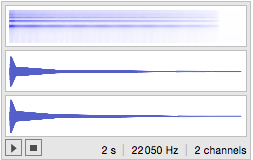Yes, that would be aliasing. Default sample rate for Play is 8000 Hz, I believe. You can set another one with option SampleRate->44100, e.g.
As a side note, totally irrelevant to you question but some fun, here is a way to generate a very simple bell sound.
Module[{f = 650., op, env},
env = Interpolation[{{0, 0.}, {0.01, 1}, {0.05, 0.3}, {0.4,
0.1}, {1.5, 0.01}, {1.8, 0}, {2, 0}}, InterpolationOrder -> 1];
op[f1_, f2_, gain2_] = env[t] Sin[2. Pi f1 t + gain2 Sin[2. Pi f2 t]];
Play[{
op[f, 3.5 f, 2.],
op[f + 5., (3.5 + 0.1) f, 2.3]
}, {t, 0, 2}, SampleRate -> 22050.]]

 Attachments:
Attachments: